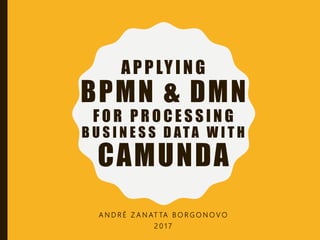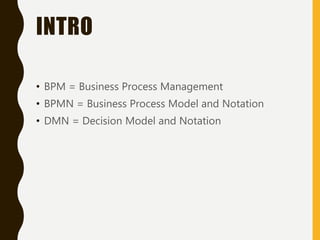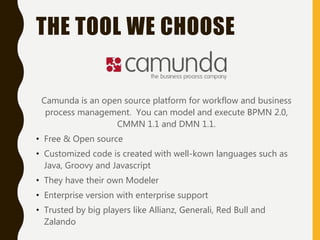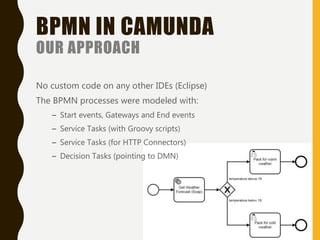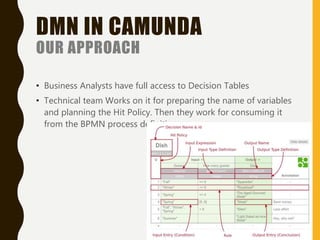BPMN and DMN for Processing Business Data with Camunda
- 1. APPLY ING BPMN & DMN F O R P R O C E S S I N G B U S I N E S S D ATA W I T H CAMUNDA A N D R ├ē Z A N AT TA B O R G O N O V O 2 0 1 7
- 2. INTRO ŌĆó BPM = Business Process Management ŌĆó BPMN = Business Process Model and Notation ŌĆó DMN = Decision Model and Notation
- 3. PROJECT VISION AND GOAL WHY WE WANTED TO USE BPM? Empower Business Analysts on having access to data processing Business Rules, so they can build it by their own and check its validity and consistency. Therefore the Business Areas are partially ŌĆ£freeŌĆØ to evolve without IT intervention.
- 4. THE TOOL WE CHOOSE Camunda is an open source platform for workflow and business process management. You can model and execute BPMN 2.0, CMMN 1.1 and DMN 1.1. ŌĆó Free & Open source ŌĆó Customized code is created with well-kown languages such as Java, Groovy and Javascript ŌĆó They have their own Modeler ŌĆó Enterprise version with enterprise support ŌĆó Trusted by big players like Allianz, Generali, Red Bull and Zalando
- 5. CAMUNDA BPM COMPARED TO ALTERNATIVES Full paper on http://network.camunda.org/whitepaper/8
- 6. BPMN IN CAMUNDA OUR APPROACH No custom code on any other IDEs (Eclipse) The BPMN processes were modeled with: ŌĆō Start events, Gateways and End events ŌĆō Service Tasks (with Groovy scripts) ŌĆō Service Tasks (for HTTP Connectors) ŌĆō Decision Tasks (pointing to DMN)
- 7. DMN IN CAMUNDA OUR APPROACH ŌĆó Business Analysts have full access to Decision Tables ŌĆó Technical team Works on it for preparing the name of variables and planning the Hit Policy. Then they work for consuming it from the BPMN process definition.
- 8. ARCHITECTURE
- 9. SOME CONSIDERATIONS ŌĆó To take the initial steps on Camunda we had a hard time. When a professional with previous experience entered the game, we really started making good steps; ŌĆó Camunda team is very available, but for professional support you need to hire them (they say the Enterprise Support). The other option is to take the community support, which was nice when we needed; ŌĆó Even if it seems to be right, test it and test it again! ŌĆó Camunda Modeler has some weird bugs, but in the end of the day you can work with it. ŌĆó Keep your services that will communicate with Camunda on the same Resource Group (same network) avoiding problems with slow data transfer through the Internet;
- 10. IMPRESSIONS & RESULTS ŌĆó Involvement of Business Analysts on rules that are actually used by the product is very beneficial for the project; ŌĆó Decision tables simplify long lists of rules, helping on organization and clarification; ŌĆó You can use Camunda without Eclipse (which is nice), but you need to know Groovy and code in a poor IDE for coding. ŌĆó We took Camunda for processing, in the first data load, plus than 100K records, plus around 25M child records. Camunda can handle it, but you need to plan and architecture its infrastructure pretty well.
- 11. USEFULL LINKS ŌĆó Camunda oficial website https://camunda.org/ ŌĆó Camunda community https://forum.camunda.org/ ŌĆó Camunda YouTube channel https://www.youtube.com/user/camundaVideo ŌĆó Web-based tooling for BPMN, DMN and CMMN https://bpmn.io/ ŌĆó Converting Excel Worksheets to DMN https://blog.camunda.org/post/2016/01/excel-dmn-conversion/
- 12. ANDR├ē BORGONOVO THANKYOU! A Z B O R G O N O V O @ G M A I L . C O M S P E C I A L T H A N K S T O T H E D E V E L O P M E N T T E A M - B R U N O L O U R E N ├ć O L O P E S - R I C A R D O L E I T E S O U Z A

